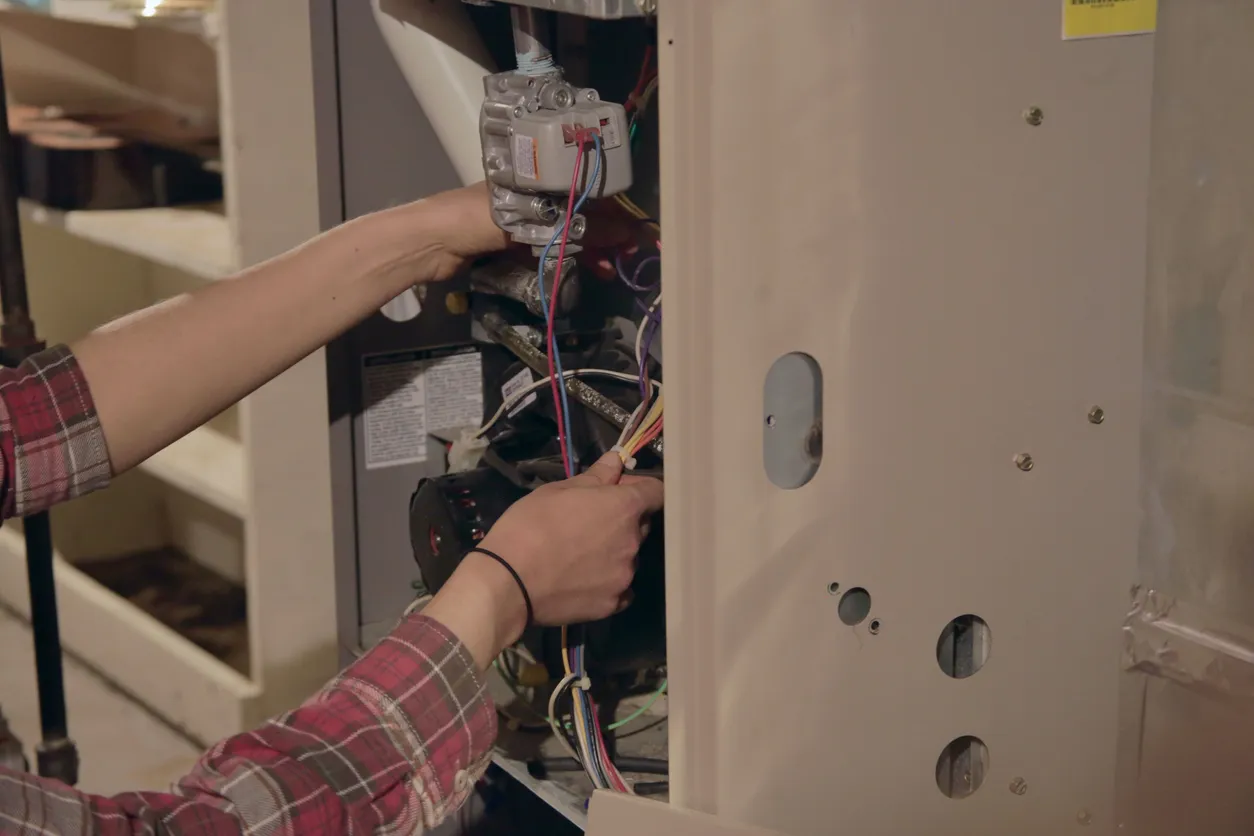
How to Prepare Your Heating System for Winter: Complete Furnace Tune-Up and HVAC Winter Preparation Guide
Winterizing a home heating system means inspecting, servicing, and optimizing the furnace, heat pump, controls, and distribution components so the system runs safely, reliably, and efficiently through colder months. In Antelope Valley and Los Angeles County, seasonal preparation focuses on occasional freezes, large daytime/nighttime temperature swings, and dry-air impacts on filters and indoor comfort; taking a few targeted steps now prevents emergency repairs later. This guide gives practical heating tips and an actionable winter furnace checklist covering DIY checks, thermostat programming, safety measures like carbon monoxide detectors, and clear criteria for when to call a professional. You will learn how a professional furnace maintenance or furnace tune-up improves safety and longevity, how to lower heating bills with thermostat and duct strategies, and which warning signs indicate a repair or replacement is needed. Read on for a step-by-step how-to checklist, expert explanations of professional tune-ups, energy-saving tactics, safety best practices, and local options for scheduling maintenance in Antelope Valley.
What Are the Essential Steps in a Winter Heating System Checklist?
A winter heating checklist lists the preventative maintenance tasks homeowners can do to preserve system efficiency, improve indoor air quality, and reduce safety risks before heavy use begins. The core mechanism is removing airflow restrictions, verifying control responses, and inspecting combustion and sealing elements so the furnace or heat pump runs with proper airflow and safe combustion. Completing this checklist reduces runtime, lowers heating bills, and exposes issues early so they can be repaired before a failure occurs. Below is a concise homeowner checklist to follow prior to the main heating season, organized as practical actions you can complete in a single afternoon with basic tools.
Follow these essential steps to prepare your heating system:
- Replace or clean the furnace air filter and note the filter type and orientation before reinserting.
- Test thermostat operation and program an efficient setback schedule for night and away periods.
- Inspect vents and registers to ensure they are open, unobstructed, and balanced for even airflow.
- Clear debris around any outdoor heat pump unit and check for visible damage or ice.
- Test smoke and carbon monoxide detectors and replace batteries if needed.
- Visually inspect duct runs for loose seams or major gaps and remove visible dust near returns.
Completing the checklist reduces common failure modes and improves performance, and it also prepares you to handle the next steps: changing filters and programming thermostats correctly to realize measurable efficiency gains.
How Do You Change and Replace Furnace Air Filters for Winter?
Changing the furnace air filter is a high-impact, low-cost step that improves airflow, protects the blower motor, and supports indoor air quality during long heating runs. Start by turning off power to the furnace at the thermostat and the service switch, then locate the filter slot at the return air grille or furnace cabinet and note the arrow indicating airflow direction.
Remove the old filter and inspect it visually: if it is dark, compressed, or clogged with dust and pet hair, replace it with the appropriate size and MERV rating; for winter in a dry climate, a MERV 6–8 filter typically balances filtration and airflow for most homes.
Properly insert the new filter following the airflow arrow, restore power, and mark the installation date on the filter frame so you can check it monthly during heavy use. Routine, correct filter changes prevent excess runtime, reduce energy use, and lower the risk of motor strain and early component wear.
How Should You Test and Program Your Thermostat for Efficient Heating?
Testing and programming a thermostat ensures the heating system responds accurately to setpoints and captures energy savings through setback schedules and smarter control logic. Begin by raising the setpoint a few degrees and verify the furnace responds promptly with warm air from vents within a few minutes; if the system delays or cycles frequently, note that behavior for possible calibration or equipment inspection.
Program a conservative setback schedule—lowering temperatures by 4–6°F during overnight and extended-away periods—to reduce heating energy consumption while maintaining comfort; many homeowners save noticeable energy without sacrificing comfort by using a 7:00–22:00 occupied schedule with modest setbacks.
If you have a smart thermostat, enable learning or scheduling features and link remote access so you can adapt schedules while away; if the thermostat is older or shows inconsistent response, consider replacement for improved savings and control. Accurate thermostat behavior links directly to reduced runtime and lower heating bills, and testing it now prevents wasted energy during peak winter use.
For professional support after trying these steps, Affordable Air and Heating offers furnace maintenance, filter guidance, and duct cleaning services in the Antelope Valley and Santa Clarita areas. If you find a clogged filter, uneven airflow, or thermostat that will not calibrate, scheduling a free estimate with a local technician can identify corrective repairs and recommend the right filter and control upgrades. Affordable Air and Heating provides tune-ups, diagnostic repairs, and indoor air quality services that connect DIY checks to lasting solutions. Requesting a professional estimate is a sensible next step when DIY actions reveal persistent problems or safety concerns.
Why Is Professional Furnace Tune-Up Important Before Winter?

A professional furnace tune-up is a focused inspection and service that validates combustion safety, optimizes heat exchange and airflow, and restores electrical and control integrity to maximize efficiency and prevent breakdowns. Technicians inspect components such as the heat exchanger, ignition system, gas connections, and blower motor and then perform targeted cleaning, lubrication, and calibration so the furnace runs within safe operational parameters. Regular tune-ups reduce the risk of carbon monoxide leaks, minimize unexpected cold-weather failures, and typically improve fuel-to-heat conversion efficiency, translating into lower monthly heating costs. Below are the common tasks performed during a tune-up and why each matters, summarized to help homeowners understand what to expect from a professional service.
A typical professional furnace tune-up includes these checks and services:
- Inspection and testing of the heat exchanger and combustion chamber for cracks or corrosion.
- Verification of ignition sequence, burner condition, and gas pressure to ensure complete combustion.
- Cleaning of blower assembly, lubrication of bearings, and tightening of electrical connections.
- Calibration of thermostat and controls, plus a test of safety devices and venting systems.
What Does a Professional Furnace Maintenance Include?
Professional furnace maintenance includes a sequence of diagnostic and service steps designed to restore safe operation and peak efficiency, typically executed during an annual visit. Technicians begin with safety checks—inspecting the heat exchanger for cracks, testing for carbon monoxide risk, verifying gas line integrity, and confirming proper venting—because combustion safety is paramount. The technician then cleans burners, inspects and, if necessary, replaces or recommends filter types, cleans the blower assembly and motor, lubricates moving parts, and tightens electrical connections to ensure reliable operation. Finally, controls and thermostats are calibrated, system runtime and combustion efficiency are measured, and the technician reviews findings and recommended next steps with the homeowner. Annual maintenance like this reduces emergency repairs, extends equipment life, and supports lower heating costs through improved efficiency.
How Does Annual Furnace Maintenance Improve Energy Efficiency and Safety?
Annual maintenance improves efficiency by restoring original airflow, removing combustion deposits, and ensuring burners and heat exchangers operate correctly, which typically yields measurable savings over time. Routine cleaning and calibration reduce the extra cycles and longer runtimes caused by clogged filters, dirty burners, or misaligned controls; many households observe a reduction in monthly heating bills after consistent yearly service. Safety benefits are substantial because trained technicians detect cracked heat exchangers, faulty ignition systems, or venting problems that create carbon monoxide exposure risks, allowing repairs before dangerous conditions develop. In a local context like Antelope Valley, preventing a mid-season failure during a cold snap is a major practical benefit, and planned maintenance is the best preventive measure. Regular tune-ups therefore deliver both cost savings and peace of mind by combining efficiency gains with rigorous safety verification.
How Can You Maximize Energy Efficiency and Reduce Heating Costs This Winter?
Maximizing winter energy efficiency combines thermostat strategy, envelope improvements (insulation and sealing), and HVAC maintenance so the system delivers comfortable heat with minimal wasted energy. The mechanism is simple: reduce heat loss through the building shell and optimize system control so the heating equipment runs fewer hours at steadier loads rather than short, inefficient cycles. A short set of high-impact strategies will often produce larger savings than piecemeal upgrades—start with thermostat scheduling, then address duct sealing and insulation in prioritized areas. The tips below explain actionable steps you can take this season and how different thermostat options compare in expected savings and convenience.
Key high-impact efficiency actions include:
- Program regular setbacks: Reduce setpoint during sleeping and long-away periods to cut energy use.
- Seal and insulate: Focus on attic, crawlspaces, and duct runs to minimize heat loss.
- Maintain airflow: Clean or replace filters regularly and keep registers unobstructed to preserve efficiency.
- Consider thermostat upgrades: Smart thermostats can automate savings and allow remote adjustments.
What Are the Benefits of Installing a Smart Thermostat for Winter Heating?
A smart thermostat provides remote control, adaptive scheduling, and usage reporting that reduce wasted heat while maintaining comfort, and its learning features can optimize setbacks without manual programming. The device connects to your home Wi-Fi and uses occupancy data, geofencing, and historical patterns to reduce temperature when the house is empty and restore comfort before occupants return, which reduces unnecessary runtime. Typical energy savings stem from consistent setbacks and avoided overheating; recent guidance indicates that proper setbacks can cut heating energy use, and smart controls help ensure those setbacks actually occur. Compatibility is an important consideration: older HVAC systems may require an adapter or professional wiring to support a smart thermostat, and a technician can verify control compatibility as part of an installation. Smart thermostats therefore combine convenience with measurable reductions in heating bills when paired with good envelope performance.
How Does Proper Home Insulation and Duct Sealing Impact Heating Efficiency?
Proper insulation and duct sealing reduce heat loss and improve distribution so the HVAC system delivers more useful heat per unit of energy consumed, shortening runtime and improving comfort uniformity. Key areas to address are the attic, rim joists, crawlspaces, and ductwork passing through unconditioned spaces; sealing seams and insulating to recommended levels lowers conductive and convective losses. Duct sealing improves delivered heat by reducing leakage that sends warm air into crawlspaces or attics, increasing system efficiency and reducing the frequency of on/off cycling. For substantial ductwork issues or insulation upgrades, professional assessment is recommended to prioritize work and ensure safe access; targeted insulation and sealing are often cost-effective investments with quick payback, especially in older homes.
What Safety Measures Should You Take to Protect Your Home During Winter Heating?
Safety measures for winter heating focus on preventing carbon monoxide exposure, reducing fire risks from portable heaters or blocked vents, and ensuring you can respond to emergencies with knowledge of shutoffs and safe practices. The mechanism linking these measures to safety is hazard removal: remove fuel sources from combustion zones, ensure alarms function to detect invisible threats, and maintain clearances to avoid ignition or overheating. Practical safety preparation includes detector testing, safe operation of space heaters, and routine inspections of chimneys, vents, and flue paths to prevent soot buildup or blockages. The short checklist and explanations below make these safety actions easy to follow for any homeowner.
Important safety actions include:
- Test and replace batteries in smoke and carbon monoxide detectors and follow manufacturer placement guidance.
- Keep portable heaters at least three feet from combustibles and never leave them unattended.
- Ensure furnace area is free of flammable materials and debris, and maintain recommended clearances.
- Schedule professional inspections for chimneys, vents, and combustion appliances before heavy use.
When Should You Call a Professional HVAC Technician for Winter Heating Issues?
Call a professional HVAC technician when diagnostic symptoms indicate safety risks, major component failure probability, or when DIY steps have not resolved performance problems; timely professional evaluation prevents breakdowns and reduces long-term costs. The mechanism that determines urgency is symptom severity: issues involving combustion, strange odors, or potential carbon monoxide exposure require immediate attention, while noise or uneven heating may be scheduled promptly but are still important to diagnose before heavy use. Below is a symptom-action mapping to help homeowners decide when to call and how urgent the response should be.
If you observe any of the following, take the recommended action:
- Persistent gas smell or alarm activation: Evacuate and call emergency services and a qualified technician immediately.
- Unusual sounds (banging, grinding): Schedule a service appointment promptly to inspect motors and bearings.
- Frequent cycling or rising bills: Arrange diagnostic service to check airflow, controls, and burners for inefficiency.
- Uneven heating or cold zones: Call a technician to evaluate duct balance and compressor or burner performance.
How Does Affordable Air and Heating Support Your Winter Heating Preparation in Antelope Valley?
Affordable Air and Heating is a family-owned and operated HVAC company serving the Santa Clarita and Antelope Valley areas with a focus on affordable heating and air conditioning services and customer satisfaction. Their service portfolio includes furnace maintenance, furnace repair and replacement, heat pump installation and repair, HVAC installation and repair, air duct cleaning, and indoor air quality solutions such as air purifiers, humidifiers, and dehumidifiers. The company emphasizes personalized comfort and offers a 100 percent satisfaction guarantee and financing options to make repairs and replacements manageable for homeowners. If you prefer help that pairs local expertise with clear estimates, scheduling a free estimate provides a technician visit, an inspection checklist, and a detailed recommendation suited to your home's needs.
How Can You Schedule a Free Estimate or Service Appointment with Local HVAC Experts?
To schedule a free estimate or service appointment, prepare basic information about your heating equipment—model numbers if available, a brief description of symptoms, and any recent maintenance history—so the technician can plan an efficient visit. Expect the technician to perform a visual inspection, test combustion and airflow performance, and provide a written recommendation with cost estimates and timeline options during the appointment. If repairs or replacement are recommended, ask about maintenance plans, financing availability, and the company’s satisfaction guarantee so you can compare options. A professional estimate converts the observations and DIY checks you’ve already run into a prioritized, actionable plan for safe, efficient winter heating.







